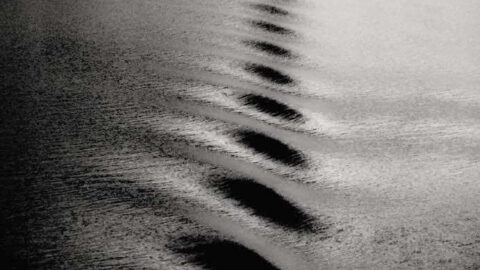Composer Charlotte Bray has recently emerged as a significant voice in chamber music. The first album dedicated entirely to her music, At the Speed of Stillness, was released in 2014 on NMC Records. In 2017, she received a British Composer Award nomination for her chamber work Chant, which was commissioned by the Ducasse Trio. Now, her second album, Charlotte Bray: Chamber and Solo Works (2018, Nimbus Records) exclusively features works for strings and piano.
Bray’s writing combines the natural resonance, the specific intensity of a bow moving over a string, and the non-tonal feedback in the sound envelope that makes the sound of a violin, viola, or cello unmistakable. The standout work on the album is On the Other Shore for solo cello, performed by Peter-Philipp Staemmler. The amount of space Staemmler creates in his interpretation of Bray’s writing is enormous—it evokes high ceilings, vaulted arches, and shafts of fading light coming through tall windows. At 3′ 49″, On the Other Shore is economical, thoughtful without being verbose, and without pulse, allowing the cellist a free-associative exploration of the material Bray has provided.

Running a close second to On the Other Shore is Beyond for solo violin, performed by Philipp Bohnen. The two works share many similarities—no distinctive pulse, creation of sonic space, economical material, and time constraints. Between the two pieces, Bray does an excellent job of highlighting what each instrument does well. On the Other Shore explores the cello’s deep low register, and Beyond allows the violinist extended time in the (soft) high register, where it has no rival. Beyond evokes the same kind of spacious contemplation as On the Other Shore, making them excellent companion pieces. Their titles/potential programs have been left intentionally vague: which shore is the other shore? (We could debate this perpetually.) Beyond what? Bray does not tell us.
Invisible Cities (performed by Barbara Buntrock, viola, and Huw Watkins, piano) sits between the extremes of writing for unaccompanied solo instruments and more conventional chamber ensembles in Bray’s repertoire. “Accompanied” is an inadequate description in this case. This is not a virtuoso showpiece for viola with the piano standing in the background, but a dialogue between the two instruments. The second movement in particular takes full advantage of this equality, with the two constantly exchanging roles. Its basis on the novel Invisible Cities by Italo Calvino seems to be more in its evocations of Venice and waterline textures—particularly in the piano writing—than in any structural or narrative similarities.
The two ensemble pieces, Züstande (piano quartet, performed by the Mariani Klavierquartett) and The Sun was Chasing Venus (string quartet, performed by Barbara Buntrock and the Amaryllis Quartett) offer a different side of Bray’s compositional lexicon. Both are excellent representatives of their respective genres, and are executed very well; however, Bray’s voice is less immediately apparent in these pieces than in her more sparse solo works. This is a fact of working in a more traditional medium that has many expectations attached to it, but Bray proves in these pieces that she can work within conventional parameters if required—an important skill for a composer.

Stylistically, these two works are very much in line with the rest of the album, both concentrating on playing with tone colors in a traditional ensemble. The colors in Züstande are inspired by different forms of ice—icebergs, glacier pieces breaking, ice fields, ice sheets, brittle ice, and the Arctic landscape—though Bray doesn’t seem to be making a direct statement about climate change. She achieves a brittle character in the first movement with soft pizzicatos, high register tremolos, and plenty of string feedback in the envelope; the danger of the third movement’s ice fields comes through in plenty of cluster chords. In the second movement, “Freely, fiercely independent,” the cello is the star, playing a lone iceberg. Of the three movements, this is the most effective.
The Sun Was Chasing Venus is the longest single-movement work on the album. Bray describes the title as not strictly programmatic, but, “an abstract impression of the work, represents the idea of a game of pursuit; musical lines chasing each other, out of which comes a sense of journey.” The pursuit is not frenetic, however, and it has moments of mysterious repose between its angular, more rhythmic episodes.
Above all, Bray’s writing for strings is architectural, evoking a structure far larger than the instrumental forces for which she has chosen to write. She is a minimalist in her materials if not in her devices, and on this album, has proven her own mastery of limited musical forces. I am particularly excited to hear more of her writing for solo instruments. I feel that in that regard she has only begun to show us what she can do.
























